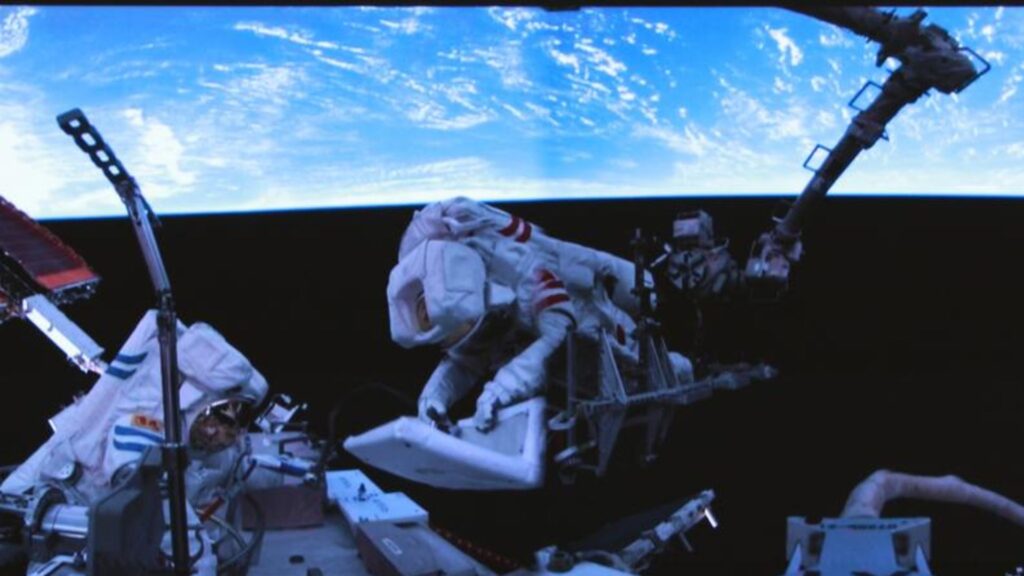Two Chinese astronauts successfully completed their second spacewalk in just over a month, conducting vital extravehicular operations outside China’s Tiangong space station on June 26. The nearly 6.5-hour spacewalk was part of the ongoing Shenzhou-20 mission, which began in April and aims to advance China’s growing capabilities in human spaceflight and space science.
At 3:04 a.m. Eastern Time (0704 UTC), astronaut Chen Zhongrui exited the Wentian module to initiate the extravehicular activity (EVA). He was soon joined by mission commander Chen Dong, who followed two hours later, both wearing Feitian EVA suits. The third crew member, Wang Jie, supported the operation from inside the station.
The astronauts installed protective shielding to safeguard Tiangong from space debris and carried out inspections and installations of external equipment and interfaces. A significant enhancement during this EVA was the use of newly fitted automated foot restraint adapters and interface adapters on the station’s robotic arm, designed to streamline future spacewalks by saving up to 40 minutes per operation.
“This upgrade means astronauts no longer need to manually install a foot limiter and operation platform on the robotic arm before each EVA,” explained Li Xuedong, the chief designer of the Tiangong station system at the China Aerospace Science and Technology Corporation (CASC), during an interview with CCTV.
The EVA concluded at 9:29 a.m. Eastern Time (1329 UTC), as confirmed by the China Manned Space Engineering Office (CMSEO). The previous EVA, conducted on May 22, lasted around eight hours and also focused on installing shielding against orbital debris.
The Shenzhou-20 mission, launched on April 24 aboard a Long March 2F rocket from the Jiuquan Satellite Launch Center, saw the crew dock with Tiangong approximately six and a half hours after launch. Since then, the astronauts have been engaged in a wide range of scientific research and maintenance tasks aboard the space station.
Experiments conducted during the mission include studies in space life sciences, microgravity physics, and emerging space technologies. The crew has used a Raman spectrometer to analyze microbiota and metabolism, investigating components in urine samples to better understand bone metabolism in microgravity.
In addition to scientific work, astronauts have carried out maintenance on exercise and life support systems and tested collaboration with an intelligent service robot named “Xiao Hang” to improve efficiency in space-human-robot interactions.
Biotechnology studies are also underway, with streptomyces bacteria samples being cultivated in a dedicated experiment cabinet. The results are being preserved in frozen storage for future analysis back on Earth.
The mission has also had an international engagement component. In early June, the crew interacted live with students and scientists in Hungary during a “Tiangong Classroom” event, answering pre-submitted questions. This was co-organized by CMSEO, the Chinese Embassy in Hungary, and the Hungarian Academy of Sciences, reflecting China’s push to use space diplomacy for soft power outreach.
This marks the third spaceflight for Chen Dong and his second stint as a mission commander. He previously led the Shenzhou-14 mission in 2022, during which Tiangong’s Wentian and Mengtian laboratory modules were installed.
Meanwhile, preparations are underway for the upcoming launch of the Tianzhou-9 cargo spacecraft, expected no earlier than July 14 from the Wenchang spaceport via a Long March 7 rocket. The resupply mission will deliver additional materials and equipment to Tiangong.
China is also developing its next-generation crew spacecraft, Mengzhou, capable of carrying up to seven astronauts. A recent pad abort test on June 17 demonstrated safety systems for the low Earth orbit variant of the spacecraft. Mengzhou will eventually launch atop the in-development Long March 10A rocket as part of China’s long-term space station expansion plans.
As China continues to solidify its place as a major spacefaring nation, the progress of the Shenzhou-20 mission highlights its commitment to both technological advancement and international cooperation.

